
The typical honeycreepers form a genus Cyanerpes of small birds in the tanager family Thraupidae. They are found in the tropical New World from Mexico south to Brazil. They occur in the forest canopy, and, as the name implies, they are specialist nectar feeders with long curved bills.
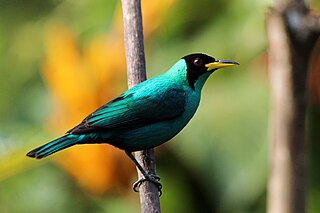
The green honeycreeper is a small bird in the tanager family. It is found in the tropical New World from southern Mexico south to Brazil, and on Trinidad. It is the only member of the genus Chlorophanes.

The purple honeycreeper is a small Neotropical bird in the tanager family Thraupidae. It is found in the tropical New World from Colombia and Venezuela south to Brazil, and on Trinidad. A few, possibly introduced birds have been recorded on Tobago.

The red-legged honeycreeper is a small songbird species in the tanager family (Thraupidae). It is found in the tropical New World from southern Mexico south to Peru, Bolivia and central Brazil, Trinidad and Tobago, and on Cuba, where possibly introduced. It is also rarely found in southern Texas.

The blue dacnis or turquoise honeycreeper is a small passerine bird. This member of the tanager family is found from Nicaragua to Panama, on Trinidad, and in South America south to Bolivia and northern Argentina. It is widespread and often common, especially in parts of its South American range.

The silver-throated tanager is a species of passerine bird in the tanager family Thraupidae. It is found in Costa Rica, Panama, Colombia, Ecuador, and northeastern Peru. It inhabits mossy forests, montane evergreen forests, tropical lowland evergreen forests and forest edges, along with tall secondary forests and disturbed habitat with remnant trees and forest. It is 13 centimetres (5.1 in) long and weighs 22 grams (0.78 oz) on average, and shows slight sexual dimorphism, with duller female plumage. Adult males are mainly bright yellow, with a silvery-white throat bordered above with a black stripe on the cheeks, black streaking on the back, and green edges to the wings and tail. Juveniles are duller and greener.

The slaty flowerpiercer is a passerine bird endemic to the Talamancan montane forests.

The purple-throated woodstar is a species of hummingbird in tribe Mellisugini of subfamily Trochilinae, the "bee hummingbirds". It is found in Colombia, Ecuador, and Panama.
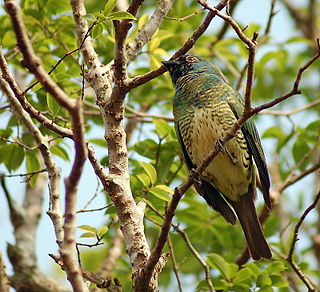
The swallow tanager is a species of Neotropic bird in the tanager family Thraupidae. It is the only member of the genus Tersina. It is found widely throughout South America, from eastern Panama to far northern Argentina. The species is sexually dimorphic: the female is a yellow-green and the male a turquoise blue with a small deep black face and upper throat patch.

The velvet-purple coronet is a species of hummingbird in the "brilliants", tribe Heliantheini in subfamily Lesbiinae. It is found in Colombia and Ecuador.
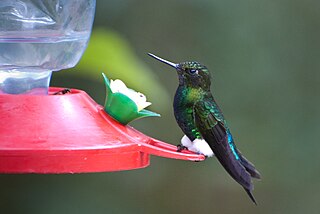
The glowing puffleg is a species of hummingbird in the "brilliants", tribe Heliantheini in subfamily Lesbiinae. It is found in Colombia, Ecuador, Peru, and Venezuela.
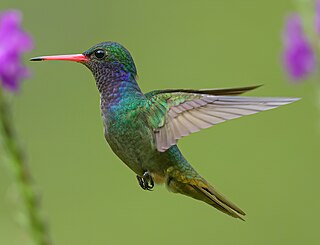
The blue-throated goldentail, also known as the blue-throated sapphire, is a species of hummingbird in the family Trochilidae. It is found in Belize, Colombia, Costa Rica, El Salvador, Guatemala, Honduras, Mexico, Nicaragua, and Panama. Its natural habitats are subtropical or tropical moist lowland forest and heavily degraded former forest.

The blue cotinga is a species of bird in the family Cotingidae. It is found in Colombia, north-west Ecuador, eastern and central Panama and western Venezuela in tropical moist lowland forests and heavily degraded former forest. In relation to range and population size this species is not considered to be vulnerable.

The Trinidad euphonia is a species of bird in the family Fringillidae. It is common in northern Colombia and northern Venezuela and uncommon to rare on the Caribbean island of Trinidad. Like all euphonias, it is small, stocky, and short-tailed; unlike some, it is sexually dimorphic. The male is glossy blue-black on the head, back, throat, and upper breast, with a bright yellow forehead and crown, and bright yellow underparts. The female is olive-green above and yellow-olive below, with a grayer patch running down the center of her breast and abdomen, and bright yellow undertail coverts. Its calls are high-pitched, plaintive whistles: the two most common are a single-pitched, double-noted "pee pee" or "tee dee", or a rising, double-noted "puwee", "cooleee" or "duu dee". Its song is a short, jumbled mix of musical and nonmusical notes.
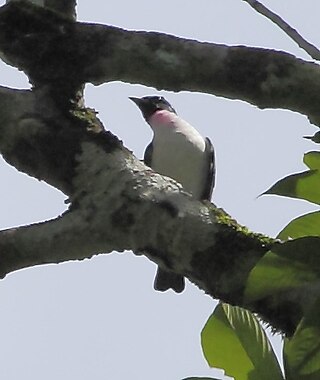
The purple-throated cotinga is a species of bird in the cotinga family, Cotingidae. It is found in the western Amazon rainforest of South America; its range extends from southern Colombia south through eastern Ecuador and Peru and east through extreme northwestern Bolivia and into western Amazonian Brazil. It lives in the canopy or along the borders of humid forest throughout its range. The purple-throated cotinga is monotypic within the genus Porphyrolaema and has no known subspecies. It is one of the smaller cotinga species and expresses strong sexual dimorphism. Males have black upperparts with a bold white wingstripe and white edges to the tertial feathers and a white belly with some black barring on the rear flanks. The throat is a deep purple, giving the bird both its common and scientific names. Females are dark brown with pale buffy margins on the upperparts, buffy cinnamon with black barring on the underparts, and rufous on the throat. The male has a powerful voice.

The purple-throated fruitcrow is a species of bird in the family Cotingidae, the cotingas. It is the only species of the genus Querula. It is native to Nicaragua, Costa Rica, Panama, and most of the northern half of South America, its habitat being humid lowland forest where it feeds mainly on insects and fruit. It is a glossy black, medium-sized bird and the male has a purple-red throat patch. It nests in close vicinity with other birds of its species. Its population is in decline, but it is a common species with a very wide range, and the International Union for Conservation of Nature has assessed its conservation status as being of "least concern".

The emerald tanager is a species of bird in the tanager family Thraupidae. It is found in Colombia, Costa Rica, Ecuador, and Panama. Described by the English ornithologists PL Sclater and Osbert Salvin in 1869, it is a medium-sized species that has a length of 10.6–13 cm (4.2–5.1 in) and a mass of 18–20.5 g (0.63–0.72 oz). It can be identified by its bright green plumage, with black streaking on the back and wings, and a black auricular patch and beak. It also has yellow on the crown and rump. The species shows slight sexual dimorphism, with the females being duller and having yellow-green in place of yellow on the head.

The cinnamon woodpecker is a species of bird in subfamily Picinae of the woodpecker family Picidae. It is found in Colombia, Costa Rica, Ecuador, Nicaragua, and Panama.
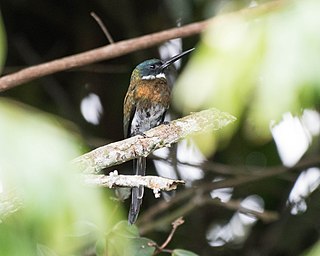
The bronzy jacamar is a species of bird in the family Galbulidae. It occurs in Bolivia, Brazil, Colombia, French Guiana, Guyana, Suriname, and Venezuela.

The crowned woodnymph or violet-crowned woodnymph is a species of hummingbird in the "emeralds", tribe Trochilini of subfamily Trochilinae. It is found from Belize and Guatemala to northern Peru.























